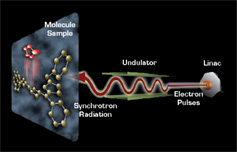
Handy Links
SLAC News Center
SLAC Today
- Subscribe
- Archives: Feb 2006-May 20, 2011
- Archives: May 23, 2011 and later
- Submit Feedback or Story Ideas
- About SLAC Today
SLAC News
Lab News
- Interactions
- Lightsources.org
- ILC NewsLine
- Int'l Science Grid This Week
- Fermilab Today
- Berkeley Lab News
- @brookhaven TODAY
- DOE Pulse
- CERN Courier
- DESY inForm
- US / LHC
SLAC Links
- Emergency
- Safety
- Policy Repository
- Site Entry Form

- Site Maps
- M & O Review
- Computing Status & Calendar
- SLAC Colloquium
- SLACspeak
- SLACspace
- SLAC Logo
- Café Menu
- Flea Market
- Web E-mail
- Marguerite Shuttle
- Discount Commuter Passes
-
Award Reporting Form
- SPIRES
- SciDoc
- Activity Groups
- Library
Stanford
Around the Bay
SLAC First in Hard X-ray Lasers
 Research and equipment at SLAC enable it to host the world's first hard x-ray laser. In the Linac Coherent Light Source (LCLS), state-of-the-art technology will harness photons with the
shortest wavelength ever corralled into coherence.
Research and equipment at SLAC enable it to host the world's first hard x-ray laser. In the Linac Coherent Light Source (LCLS), state-of-the-art technology will harness photons with the
shortest wavelength ever corralled into coherence.
Soft x-ray lasers harness photons with wavelengths greater than one nanometer. SLAC will use hard x-rays, whose one nanometer and smaller wavelengths possess higher energies.
In a traditional laser, electrons release photons as they drop to a lower energy orbital around their atoms. Those found in grocery store scanners and laser pointers typically use light within the visible spectrum and require electrons to bounce between mirrors millions of times until they radiate light in phase. But by doing so, Arthur says, the efficiency of the process dwindles.
X-ray lasers escape these constraints by using free electron laser (FEL) technology that uses an electron beam rather then electrons bound to atomic or molecular states. "They're actually rather expensive, but free from atoms," says SLAC's John Arthur. In the LCLS, the free electron laser hurls an electron beam at nearly the speed of light down 33 undulators which compress the electrons' wavelength by a factor of 30.
Photons radiating from electrons near the back of the pulse travel faster than electrons leading the charge. As the light overtakes the negatively charged particles, it nudges them to undulate in phase. In what's called the self-amplified spontaneous emission of photons, the pulse of electrons emits light coherently in a single trip down the undulators rather than over millions of reflections.
Although FEL was first developed in the 1970s, a lack of suitable technology kept hard x-ray lasers in the design stage until about 1990. At SLAC, the linear accelerator capable of reaching 14 GeV, a high-power cathode gun, and the giant undulator put the LCLS in a unique position to create the world's first hard x-ray laser.
"All those things aren't just lying around," Arthur points out. "SLAC is the only place this is currently possible."
—Krista Zala SLAC Today, April 24, 2006